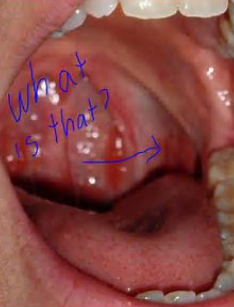Mast Cell Activation may be another clue that Chronic Fatigue Syndrome involves Kaposi's Sarcoma.
Mast Cell Activation and KSHV Infection in Kaposi Sarcoma
http://clincancerres.aacrjournals.org/content/24/20/5085
Mast Cell Activation May Underlie 'Chronic Fatigue Syndrome
Could the Brain’s Mast Cells Be Causing Chronic Fatigue Syndrome (ME/CFS)?
"Persons infected with KSHV can asymptomatically shed the virus. It is advised to practice safe sex with infected individuals and curtail activities where saliva might be shared during sexual activity."
http://www.herpes.com/hhv-8.html
This is what oral Kaposi's Sarcoma looks like.
Source: https://doctorspiller.com/kaposis-sarcoma/
Compare it to these crimson crescent lesions in the mouths of Chronic Fatigue Syndrome patients.
"Burke A. Cunha, MD, discovered what he called crimson crescents in the mouths of 80% of his CFS patients. After the word got out, Cunha received calls from other parts of the country. Physicians began telling him that they also were finding the crimson crescents in their patients once they looked for them."
https://www.prohealth.com/library/crimson-crescents-facilitate-chronic-fatigue-syndrome-cfs-diagnosis-11266
Chronic Fatigue Syndrome patients may have undiagnosed internal Kaposi's Sarcoma. Susan Levine found HHV-8, the Kaposi's Sarcoma virus, in half of CFS patients she looked at.
Prevalence in the Cerebrospinal Fluid of the Following Infectious Agents in a Cohort of 12 CFS Subjects
Susan Levine
Published online: 04 Dec 2011
ABSTRACT
Over the last decade a wide variety of infectious agents has been associated with the chronic fatigue syndrome (CFS) as potential etiologies for this disorder by researchers from all over the world. Many of these agents are neurotrophic and have been linked previously to other diseases involving the central nervous system (CNS). Human herpes virus-6 (HHV-6), especially the B variant, has been found in autopsy specimens of patients who suffered from multiple sclerosis. Because patients with CFS manifest a wide range of symptoms involving the CNS as shown by abnormalities on brain MRIs, SPECT scans of the brain and results of tilt table testing we sought to determine the prevalence of HHV-6, HHV-8, Epstein-Barr virus (EBV), cytomegalovirus (CMV), Mycoplasma species, Chlamydia species, and Coxsackie virus in the spinal fluid of a group of 12 patients with CFS. Although we intended to search mainly for evidence of actively replicating HHV-6, a virus that has been associated by several researchers with this disorder, we found evidence of HHV-8, Chlamydia species, CMV and Coxsackie virus in 6/12 samples. Attempts were made to correlate the clinical presentations of each of these patients, especially the neurological exams and results of objective testing of the CNS, with the particular infectious agent isolated. It was also surprising to obtain such a relatively high yield of infectious agents on cell free specimens of spinal fluid that had not been centrifuged. Future research in spinal fluid analysis, in addition to testing tissue samples by polymerase chain reaction (PCR) and other direct viral isolation techniques will be important in characterizing subpopulations of CFS patients, especially those with involvement of the CNS.
https://www.tandfonline.com/doi/abs/10.1300/J092v09n01_05
Everything you wanted to know about Kaposi’s Sarcoma in Chronic Fatigue Syndrome patients and the growing CFS epidemic of HHV-8, one of the two or three viruses that may be causing Kaposi’s Sarcoma.
Excerpted from The
Chronic Fatigue Syndrome Epidemic Cover-up, a bestseller on Amazon.
Neenyah Ostrom began one of my favorite series
of articles in the same issue. Titled “The Color Purple,” Ostrom reported,
“Burke Cunha, M.D. who is chief of infectious disease at Winthrop-University
Hospital (Mineola, Long Island), has described what he calls ‘crimson
crescents’ that appear in the throats of more than 80 percent of chronic
fatigue syndrome (CFS) patients. Cunha describes the crescents not only as
‘crimson,’ but ‘purplish.’ The reddish-purplish regions found in CFS patients’
throats sounded quite similar to KS (Kaposi’s sarcoma) in the throat, commented
an ‘AIDS’ doctor [who wished to remain anonymous] to whom they were described.
Is it possible that the crimson crescents observed in the throats of CFS
patients are actually a type of KS?” Ostrom
raised the possibility that the lesions in the throats of CFS patients
connected them to the theory that Florida researchers held about KS being the
unrecognized but unifying central pathological event AIDS. As I previously
reported, the Florida team, headed by Dr. George Hensley, had turned the AIDS
paradigm upside down, by finding KS in nearly 100% of AIDS patients, when they
explored the internal organs closely during autopsies of AIDS patients. Their
fascinating work suggested that KS preceded AIDS and caused more of the immune
problem in AIDS than previously thought.
Basically, Ostrom
was asking if the KS-like lesions, in the tonsils of [CFS]patients, were an
indication that some kind of unrecognized indolent KS was present internally,
something that physicians would not even be thinking about because of the
conceptual wall that socially hostile epidemiology had built between AIDS and
chronic fatigue syndrome. And the CFS patients were not particularly interested
in finding out if they shared KS with AIDS patients.
Ostrom went even
further, in the July 20 issue, and speculated that the dramatic digestive
problems in chronic fatigue syndrome were actually the result of the
unrecognized chronic or slowly progressive KS in the CFS patients’ digestive
tracts. Ostrom noted that Dr. Carol Jessop, who was talking to a group of
patients at a chronic fatigue syndrome conference, said, “Almost all patients
would say to me, ‘I was totally well until I got this [chronic fatigue
syndrome],’ and yet, when I took their past medical histories, I found it
wasn’t quite true. Now these aren’t disastrous problems. In fact, if they had
gone to their physicians for any of these problems such as irritable bowel,
diarrhea and constipation, abdominal cramping, bloating, flatulence, chronic
constipation, heartburn, etc., their physician would probably just say, ‘Oh,
take this’ and that would be it. So we as physicians didn’t relate to our patients
that this was a problem, so they considered themselves to be totally healthy.
Yet, if you look at the numbers, 89 percent of the [chronic fatigue syndrome]
patients had irritable bowel syndrome, diarrhea alternating with constipation,
and abdominal cramping pain episodically. Another 80 percent complained of
constant gas, bloating and flatulence. It’s amazing that we can all meet in
this room together.” Ostrom wondered if
“Jessop may have uncovered a fallacy in the prevailing wisdom of chronic
fatigue syndrome: that it begins as a respiratory, flu-like illness. Instead,
as she points out, it may be a digestive tract disturbance. Jessop’s
statistic—that more than 80 percent of CFS patients complain of irritable bowel
syndrome, abdominal pain, gas, bloating, etc.—corresponds to the more than 80
percent of CFS patients who exhibit a red-to-purplish crescent-shaped lesion in
their throats. (Helot, Paul, in the New York Times Long Island edition, January
14, 1992) . . . What if the digestive problems described by the CFS patients
are actually caused by KS in the gastrointestinal tract? According to the AIDS
Treatment News, ‘The most common HIV-related causes of gastric symptoms include
KS, lymphoma, and CMV [cytomegalovirus].’ And while KS is unusual in the
esophagus, it ‘may occasionally be found there.’ KS also can cause colitis and
diarrhea . . . in people with AIDS.” Ostrom noted, “Gastrointestinal symptoms,
it is realized in retrospect, were among the first signs of the ‘AIDS’
epidemic; and, it now seems, were also among the first symptoms seen in the CFS
epidemic. That observation raises what should be a relatively simple question
to answer: Are the gastrointestinal symptoms in both patient populations
caused, in part, by undetected KS?”
Excerpted from The
Chronic Fatigue Syndrome Epidemic Cover-up, a bestseller on Amazon.
Important
information about the Kaposi’s Sarcoma problem in Chronic Fatigue Syndrome
Whatever
happened to the concern about controlling the Kaposi's Sarcoma Virus? What
about all the infected Chronic Fatigue Syndrome patients?
Is Kaposi's
Sarcoma responsible for the digestive disorders in Chronic Fatigue Syndrome?
HHV-8 is a
Kaposi's Sarcoma cancer virus in many AIDS and Chronic Fatigue Syndrome
patients and is spread by kissing but the CDC couldn't care less.
Company
founded by Robert Gallo suggests 65% of gay men are infected with Kaposi's
Sarcoma virus.
Coagulation
issues may link Chronic Fatigue Syndrome, Kaposi's Sarcoma, and AIDS
Should
Chronic Fatigue Syndrome be added to the spectrum of Kaposi's
Sarcoma-Associated Herpesvirus, or Human Herpesvirus 8, Diseases?
Why Susan
Levine may have done the world's most important research on Chronic Fatigue
Syndrome.
Does HHV-8
viral load raise questions about the legitimacy of HIV viral load?
Can Chronic
Fatigue Syndrome patients with internal Kaposi's Sarcoma pass it on to their
partners?
Can most of
the symptoms of Chronic Fatigue Syndrome described by Paul Cheney be attributed
to internal Kaposi's Sarcoma?
Is Chronic
Fatigue Syndrome Associated Kaposi's Sarcoma
(CFSKS) a diagnosis all doctors should become aware of?
Stanford
University and Open Medicine Foundation should have a conference on diagnosing
Kaposi's Sarcoma in Chronic Fatigue Syndrome.
Why are
doctors not looking for Kaposi's Sarcoma in Chronic Fatigue Syndrome patients?
If Chronic
Fatigue Syndrome involves HHV-8 and Kaposi's Sarcoma, scientists will have to
ask if it came from pigs.
Does the Red
Blood Cell Deformability Issue Link Chronic Fatigue Syndrome to Kaposi's
Sarcoma and AIDS?
Will the
Montoya cytokine study show that Chronic Fatigue Syndrome is Kaposi's Sarcoma
Inflammatory Syndrome?
Is Chronic
Fatigue Syndrome a Kaposi's Sarcoma inflammatory cytokine syndrome?
How Kaposi's
Sarcoma almost undermined the HIV theory of AIDS
How did 50%
of Chronic Fatigue Syndrome patients become infected with a Kaposi’s Sarcoma cancer
virus?
Has the
moment finally come to address the issue of Kaposi's Sarcoma in Chronic Fatigue
Syndrome?
Oral
Kaposi's Sarcoma looks like the Crimson Crescents in Chronic Fatigue Syndrome
patients.
Were oral
crimson crescents the first obvious sign of Kaposi's Sarcoma in Chronic Fatigue
Syndrome patients?
Did Paul Cheney
ever consider the possibility that Chronic Fatigue Syndrome patients have
internal Kaposi's Sarcoma?
Is the red
blood cell deformability issue another clue that Chronic Fatigue Syndrome is
also a Kaposi's Sarcoma Syndrome?
Why is
nobody warned about exposure to HHV-8, the Kaposi's Sarcoma virus that even
patients with Chronic Fatigue Syndrome are sometimes infected with?
Do petechiae
in Chronic Fatigue Syndrome connect it to Kaposi's Sarcoma, HHV-8, and AIDS?
Whatever is
causing Kaposi's Sarcoma may be the real cause of Chronic Fatigue Syndrome and
AIDS.
A massive
epidemic of Kaposi's Sarcoma may be coming.
When
Kaposi's Sarcoma almost turned AIDS upside down.
Human
herpesvirus 6 activates lytic cycle replication of Kaposi's sarcoma-associated
herpesvirus.
All AIDS
patients have some form of Kaposi's Sarcoma in this study. Is the same true for
Chronic Fatigue Syndrome?
Crimson
crescents may suggest that all Chronic Fatigue Syndrome patients have Kaposi's
Sarcoma.
Do all
Chronic Fatigue Syndrome patients have an indolent form of Kaposi's Sarcoma?
Are these
marks on the skin a sign of Kaposi’s Sarcoma in Chronic Fatigue Syndrome?
On autopsy,
do the inflamed ganglia of Chronic Fatigue Syndrome patients resemble Kaposi's
Sarcoma?
What people
don't know about Kaposi's Sarcoma in Chronic Fatigue Syndrome and AIDS.
Do all
Chronic Fatigue Syndrome patients show internal Kaposi's Sarcoma upon autopsy?
Decades ago,
a New York newspaper sounded the alarm about Kaposi’s Sarcoma in Chronic Fatigue
Syndrome. The book about that newspaper is now a must-read bestseller on Amazon.
Purchase a hardcover, paperback, or Kindle version here.

















